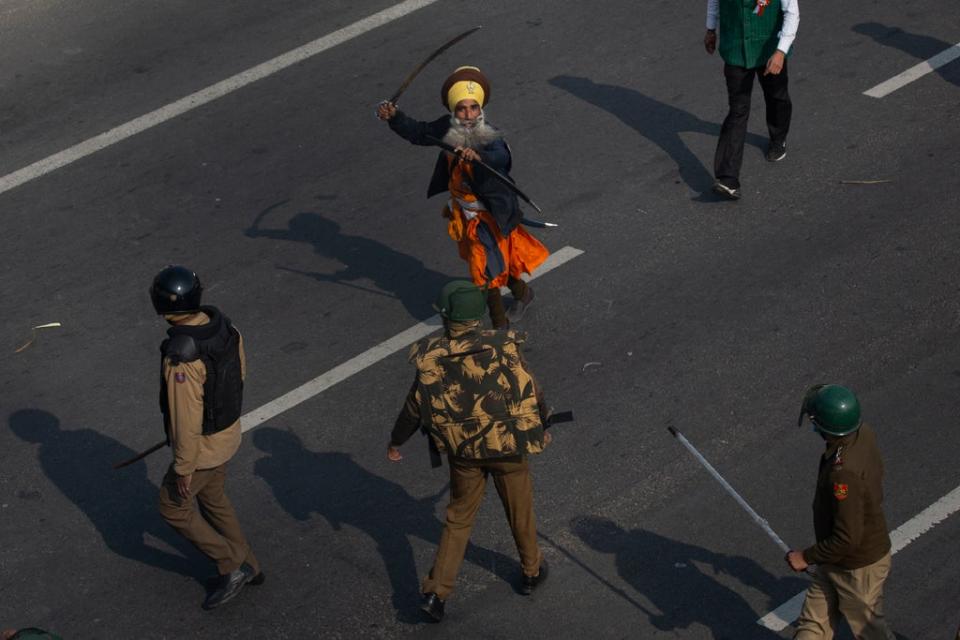Who are the Nihangs? The ultra religious Indian group accused of lynching labourer

The Nihangs are reclusive Sikh warriors who have gained public attention in India after one of their group members admitted to brutally killing a man last week amid ongoing farmers protests in the country.
Videos of the murder, in which a man’s arm and leg were chopped off and his body was hung near one of the protest sites, led to a heated political debate that embroiled the warriors.
The members of the Sikh warrior sect are trained in martial arts and wrestling and are believed to be “Akalis”: those who have conquered death and are always willing to sacrifice their lives.
The Nihangs sometimes arm themselves with medieval-era weapons such as swords, daggers and spears. On some occasions, they are seen carrying rifles, shotguns and pistols as well.
They can be spotted from afar as they are usually clad in electric-blue robes along with turbans that are significantly larger than their heads.
Their exact period of origin is not known, but scholars believe the sect can be traced back to the late 17th century.
The Nihangs are said to have fought Mughal and Afghan invaders. After the British occupied India, they channelled the military traditions of the Nihangs into modern Sikh regiments.
Members of the Nihang sect rode towards Delhi on horseback last year to join thousands of farmers who have still been protesting against three farm laws passed by the ruling Bharatiya Janata Party (BJP).
At the heart of the controversy over the Nihangs lies the brutal murder of 35-year-old Sikh labourer Lakhbir Singh, who was from the northern, agrarian Indian state of Punjab, where the farmer protests have been the most intense ever since they started.
Singh was allegedly executed by Nihang members at one of the protest sites on the outskirts of Delhi.
A grisly video of the incident showed Singh strung up, and still half conscious at the time, with a hand chopped off and a foot hacked at the ankle, along with multiple wounds that appeared to have been caused by sharp weapons.
He reportedly pleaded for death before dying from his injuries.
After the video went viral and caused a nationwide uproar, at least four members of Nihang sect surrendered and confessed to the killing, saying Singh allegedly “desecrated” the holy book of the Sikhs.
Opposition party leaders and farmer groups, however, have now suggested that the murder could have been a sinister, politically motivated conspiracy to derail the farmer agitation.
The allegations came after a purported photograph of federal agriculture minister Narendra Singh Tomar and another BJP leader meeting Aman Singh, a Nihang leader, surfaced.
Nihang Baba (whose members are accused of killing Dalit at Sinhgu) admits to secretly meeting Union Agri Minister Tomar, claims 'offered Rs 10 lakh' to vacate dharna site.
‘I did not go alone to meet Tomar. At least 10 members of our ‘fauj’ were with me'. https://t.co/zdfaywsech— Prashant Bhushan (@pbhushan1) October 20, 2021
Mr Singh, the leader of one of the Nihang groups, had previously justified the killing of the man, calling it “punishment for blasphemy”, while warning farmer leaders to “think twice before announcing their views” on the lynching.
The viral picture stirred up more controversy after Mr Singh alleged he was offered Rs 1 million (£9,672) to order Nihangs to leave the farmers protest site, reported the Indian Express newspaper.
“I was offered Rs 1 million for leaving the farmers’ protest site; Rs 100,000 (£968) was offered to my organisation also. But we can’t be bought,” Mr Singh alleged on Tuesday. He said the Nihang organisations would take a call on 27 October, on whether to stay at the protest site or not.
“I want to ask those that are saying the Nihang Singhs took the law into their hands, that beadbis of Dhan Guru Granth Sahib Maharaj have been occurring since 2015, the law was in your hands, did you give us justice?”
1/2 pic.twitter.com/jR8qkcxP6r— ਰਮਨੀਕ ਕੌਰ (@SidhuRamnik) October 16, 2021
“In view of the recent disclosures about one of the Nihang leaders having already been in touch with the Government of India, Minister for Agriculture NS Tomar in particular, the lynching incident has now taken an entirely different turn,” Punjab’s deputy chief minister Sukhjinder Singh Randhawa said in a widely reported statement.
“There appeared to be a deep-rooted conspiracy to defame the farmers’ stir,” the minister claimed.
The federal agriculture ministry, however, claimed the meeting was held in July and was not an official meeting, according to The Hindu newspaper. The ministry said it took place at the residence of junior federal agriculture minister, Kailash Choudhary.
The Samyukt Kisan Morcha, the umbrella body of farmer unions spearheading the ongoing protests, also claimed the murder to be a conspiracy.
The group said in a statement that the murder sought to deflect attention from another incident at Lakhimpur Kheri, where another federal minister’s son allegedly ran over protesting farmers on a vehicle.
The farmer union now demands a comprehensive investigation over the incident.
Mr Randhawa said the Punjab government would do everything in its capacity to get to the root of the “conspiracy” and punish the culprits.

 Yahoo Finance
Yahoo Finance 